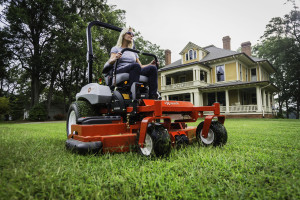Deciding on the perfect lawn mower is only the first step in taking control of your lawn. Although a high-end mower will go a long way in making sure your landscaping efforts are the envy of the neighborhood, regularly cutting the grass is only a small part of lawn maintenance.
If you’re not sure whether you’d like to mulch your grass clippings, bag them and toss them out, or blow any excess yard debris out of the way, here is an overview of each option.
Mulching Grass Clippings
In today’s age of eco-friendly initiatives and greener lifestyles, mulching (or “grasscycling”) is becoming an increasingly popular choice for both homeowners and commercial landscapers. Although large and unwieldly clumps of grass are both unsightly and damaging, mulched grass provides a natural and low-cost fertilizer to help keep your lawn looking greener for longer.
Grass clippings are almost entirely composed of water, which makes them a natural and easy source of hydration for your lawn. They also put up to 25 percent of the lawn’s nutrients and nitrogen back into the soil—thereby reducing your need to fertilize or add growth stimulants to your lawn. And as long as they’re less than one inch in size (which should be the case if you mow on a regular schedule), they’ll fall naturally down to the root zone of the grass and break down, which means you don’t have to do anything but let the grass clippings fall where they may.
If it’s been awhile since you last mowed, if you mow damp grass, or if your mower blades are becoming dull, you may need to do a little extra work since the mulch could clump. Most of the time, spreading the grass clippings out with a rake will do the trick. The other option is to bag portions of the mulch to be distributed at a later date (or to put somewhere like a garden or even compost heap).
Bagging Grass Clippings
Cleaning up grass clippings from the lawn and putting them into bags to be disposed of became popular in the 1950s, but the practice has fallen out of favor for some. In large part because it creates more work, requiring you to either rake the clippings from the yard or frequently stop to empty the bagged clippings. Either way, there’s an additional step required.
Because grass clippings are such a healthy part of lawn maintenance, and they could be put to better use in the garden, bagging them with the intent to throw them away tends to be viewed as wasteful. However, there are incidences when bagging needs to be done. When you’re mowing a very long yard, for example (with grass blades that are several inches tall), the clippings will be too big to be used as fertilizer. In this case, you’ll most likely need to bag the clippings and dispose of them. This can be done by throwing them out or by turning them into compost, as they are still very nitrogen- and nutrient-rich.
Blowing Grass Clippings
A third—and not very common—option is to blow the grass clippings out of the way so they don’t prove unsightly in a freshly mowed yard. This can be great if you plan to do your own edging and sidewalk cleanup afterward, but can also be an annoyance if you blow the clippings into communal neighborhood areas like the street.
Most of the time, people choose to blow because there is more than just grass mulch in the yard. Leaves, weeds, small twigs, and other debris that collect over time aren’t as nutrient rich as the grass clippings, and leaving them sitting can be damaging to your lawn over the long-term.
Here’s a better strategy: Instead of blowing the grass after you mow the lawn, we suggest you do the blowing first. That way, you remove the harmful yard debris and can bag it up separately. Then, after you mow, the only mulch is made of grass clippings, which can be left in place to provide nutrients and keep your lawn looking great.
SHARE







